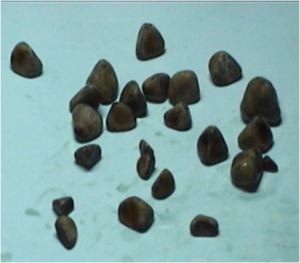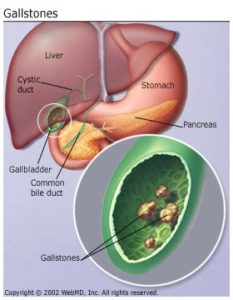Ultra sound scans are suggested for abdominal pain, especially in master health checkups. This has thrown a lot of light on gall bladder stones about which the patients hitherto were blissfully unaware, points out, Dr.G.Sivakumar, Consultant General Surgeon.
When the medical report confirms the presence of gallstones, the patients are perturbed. They often enquire the doctors about the nature of the disease and the need for surgery for removal of gall stones. These form when liquid stored in the gallbladder hardens into pieces of stone-like material. The liquid, called Bile, is used to help the body digest fats. Bile is made in the liver, and stored in the gallbladder until the body needs bile to digest fat. At that time, the gallbladder contracts and pushes the bile into bile duct—that carries it to the small intestine, where it helps digestion.
Bile contains water, cholesterol, fats, bile salts, and bilirubin. Bile salts break up fat, and bilirubin gives bile and stool a brownish color. If the liquid bile contains too much cholesterol, bile salts, or bilirubin, it can harden into stones.
The two types of gallstones are cholesterol stones and pigment stones. Cholesterol stones are usually yellow-green and are made primarily of hardened cholesterol. They account for about 80 percent of gallstones, in the west. Pigment stones are small, dark stones made of bilirubin and are the commonest stones in chennai. Gallstones can be as small as a grain of sand or as large as a golf ball. The gallbladder can develop just one large stone, hundreds of tiny stones, or almost any combination.
Gall Stones
• Majority of people with gallstones never experience any symptoms.
• Others remain asymptomatic (without symptoms) for at least two years after the stone formation begins.
• If symptoms do occur, the chance of developing pain is about 2% per year for the first ten years after the stone formation, after which the chance for developing symptoms decrease.
• The most common symptom of gall bladder disease is intermittent pain called biliary colic, which occurs either in the mid-right or the upper-right portion of the upper abdomen.
• A sumptuous, fatty and spicy lunch or dinner can precipitate the pain, but it usually occurs several hours after eating, often at night.
How are gall stones formed?

Gall stones are formed from bile, a fluid composed mostly of water, bile salts, lecithin, and cholesterol. They are composed of calcium bilirubinate, or calcified bilirubin, the substance that is formed by the breakdown of haemoglobin in the blood. These black stones often form in the gallbladders of people with malaria, haemolysis, malnutrition and myxoedema. Cholesterol disorders can also produce gall stones.
Gallstones can range from a few millimeters to several centimeters in diameter. About 90% of the gall stones found in the South Indian population are formed from bile pigments.Cholesterol stones constitute only a small portion of stones.
What are the functions of bile and the gall bladder?
Bile is produced by the liver and is needed for the digestion of fat. It is secreted through tiny channels within the liver into a duct. From here, the bile passes through a larger tube called the common duct, which leads to the small intestines. The gallbladder is a four-inch sac with a muscular wall that is located under the liver. The gallbladder serves as a reservoir until bile is needed in the small intestine for the digestion of fat.
Gall Stones and Related Problems:
• The most common symptom of gallbladder disease is intermittent pain called biliary colic, which occurs either in the mid-right or the upper-right portion of the upper abdomen. The pain can be quite severe and may be accompanied by nausea.
• Inflammation of the gallbladder (acute cholecystitis) is a more serious problem than biliary colic. It begins abruptly and it needs immediate surgical management. Acute cholecystitis is usually caused by gallstones, but, in some cases, can occur without stones. Empyema (pus collection) of the gallbladder, or pus in the gallbladder, occurs in 2% to 3% of patients with acute cholecystitis. Abdominal pain is usually severe.
• Stones lodged in the common bile duct (choledocholithiasis) can block the flow of bile and cause jaundice. Presence of stones does not necessarily explain a patient’s pain, which may be due to various other conditions.
• Asymptomatic gallstones seldom lead to problems. Serious effects from gallstones are usually from stones in the bile duct or gall bladder developing surgical complications.
• Gallbladder cancer is very rare but is always caused by gall stones. Oriental population is at a slightly increased risk of developing stone-related gall bladder cancer
• Gall stones are responsible for about 45% of all cases of acute pancreatitis (acute inflammation of the pancreas), a condition that can be life threatening. Obesity in both men and women increases the risk for gallstones.
Diagnosis of Gall Stones:

Pic courtesy: webmd.com
Ultrasound, the diagnostic method most frequently used to detect gallstones, is a simple, rapid, and non-invasive imaging technique. Ultrasound detects gallstones as small as two millimeters in diameter with an accuracy of 90% to 95%.
If there is evidence for common bile duct stones, such as dark urine, jaundice, pancreatitis, or elevated liver function tests, then more extensive tests, such as ERCP(Endoscopic Retrograde Cholangio Pancreaticography), may be used. This procedure involves the use of an endoscope – a flexible telescope containing a miniature camera and other instruments – which is passed through the mouth, the stomach and into the upper small intestine, where the bile duct emerges.
Ultrasound, which is accurate in diagnosing gallstones, can diagnose stones in the common bile duct only about 50% of the time. Studies report that Magnetic Resonance Imaging (MRI) techniques and cholangiography, which are not invasive, are almost as accurate as ERCP in identifying normal and abnormal ducts.
Treatment of Gall Stones:
Though it may sound hard to believe, resorting to Indian food regimen: that is, rescheduling the principal meal to ten a.m, taking mainly vegetarian food, and observing partial or complete fasting on certain days of the month can help in the reduction of the formation of gall stones.
Despite wishful thinking, gall stones seldom disappear spontaneously. Statistics show that every year thousands of people have their gallbladders removed. The gallbladder, however, is not an essential organ.
Even today, only surgical removal of the gallbladder (cholecystectomy) guarantees that the patient will not suffer a recurrence of gall stones. The advantages of surgical removal of the gallbladder over non-surgical treatment are the elimination of gallstones, and the prevention of gallbladder cancer.
Until the early 1990s, open cholecystectomy was the standard treatment. Now, laparoscopic cholecystectomy, which uses keyhole incisions, is the most commonly used surgical approach. First performed in 1987, laparoscopy is now used in nearly 60% of all cholecystectomies.
In laparoscopy, removal of the gallbladder is guided by a laparoscope. The standard surgery is called laparoscopic cholecystectomy. For this operation, the surgeon makes several tiny incisions in the abdomen and inserts surgical instruments and a miniature video camera into the abdomen. The camera sends a magnified image from inside the body to a video monitor, giving the surgeon a closeup view of the organs and tissues. While watching the monitor, the surgeon uses the instruments to carefully separate the gallbladder from the liver, ducts, and other structures. Then the cystic duct is cut and the gallbladder removed through one of the small incisions.
Because the abdominal muscles are not cut during laparoscopic surgery, patients have less pain and fewer complications than they would have had after surgery using a large incision across the abdomen. It is not usually the procedure of choice for people with acute cholecystitis in whom gangrene and peritonitis has developed.Oral dissolution therapy uses bile acids in pill form to dissolve gallstones. In India, we find gall stones that are calcified or composed of bile pigments and are not amenable to oral dissolution therapy.
Pic courtesy: livescience.com
